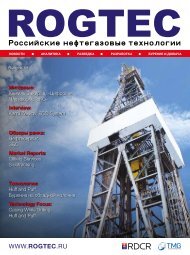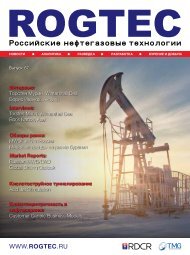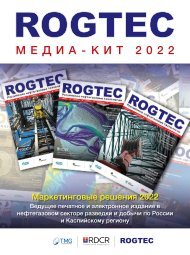ROGTEC Magazine Issue 61
Russian Oli & Gas Magazine
Russian Oli & Gas Magazine
You also want an ePaper? Increase the reach of your titles
YUMPU automatically turns print PDFs into web optimized ePapers that Google loves.
УМНЫЕ СКВАЖИНЫ
надежных количественных критериев, требуемых
для настройки соответствующих гидродинамических
моделей для систем скважина – пласт(ы).
Указанные условия необходимы для получения
экономического эффекта от цифровизации и
оптимизации разработки путем оперативного
управления работой скважин и пластов. Однако
цель создания СИИС удаленно- го непрерывного
гидродинамико-геофизического мониторинга
при обустройстве эксплуатационных скважин не
сводится только к достижению максимальной
цифровизации и оперативности при проведении
диагностики работы скважин и пластов.
Реальной технической задачей становится
уменьшение потерь добычи продукции, связанных с
необходимостью длительных простоев добывающих
скважин при проведении в них стандартных
комплексов промыслово-геофизических (ПГИ)
и гидродинамических (ГДИС) исследований,
предписанных в РФ лицензионными соглашениями
и федеральными регламентными документами с
целью обеспечения должного контроля разработки.
Рассмотрим один из типичных аспектов данной
проблемы. Для достижения требуемого согласно
положениям действующих отраслевых руководящих
документов уровня информативности ГДИС
(получение количественных оценок текущей фазовой
проницаемости, скин-фактора призабойной зоны
пласта, уточнение геометрии залежи, учет фактора
влияния соседних скважин и др.) длительность
вынужденной остановки добывающей скважины при
проведении традиционного исследования с записью
кривой восстановления давления (КВД) для пластов
с абсолютной проницаемостью (0,1–2)⋅10 -3 мкм 2 (что
соответствует категории ТРИЗ) составит десятки
суток или даже месяцы (для фиксации режима
радиального притока).
Геофизические и гидродинамические средства
СИИС, до настоящего времени эпизодически
применяемые в разных нефтяных компаниях,
подтолкнули к созданию и развитию
нового технологического направления в
нефтегазопромысловом деле – стационарного
удаленного гидродинамико-геофизического
мониторинга добывающих скважин
Как правило, нефтяные компании на
месторождениях ТРИЗ на это не идут, проводя
заведомо некондиционные короткие записи КВД. В
итоге либо фактически сокращается объем ГДИС
в процессе эксплуатации, либо они выполняются
некорректно, что отражается как на изученности
объектов разработки и эффективности применяемых
52 ROGTEC
logging and hydrodynamical testing – studies that are
required in Russia in the licensing arrangements and
state regulatory documents in order to achieve the goals
for the fields development. Let’s revise one of the typical
sides of the issue. In order to satisfy the requirements
for conventional well testing (pressure recovery curve
logging with quantitative estimations of instant effective
permeability and skin-factor of near-wellbore formation
zone, refinement of formation’s geometry, adjacent wells’
influence etc) as per valid industry-specific regulatory
documents, a well which produces from low-permeable
formations with absolute permeability of 0.1-2 . 10 -3 um 2 –
which corresponds to unconventional reservoirs – must
be shut down for dozens of days or even for several
months (if a radial flow regime is under consideration).
Systems for permanent geophysical and
hydrodynamical monitoring that have been
sporadically implemented within various oil producing
companies prompted the development of an innovative
technological trend amongst oil and gas engineering
disciplines namely permanent remote hydrodynamic
and geophysical monitoring of production wells.
As a rule, oil producers intentionally don’t perform
full-scale well tests at unconventional reservoirs. This
practice basically either reduces the required volume of
well testing logging or compromises its results.
Consequently, the development targets state of
exploration, the efficiency of geological and technical
operations based on the results of the well test (including
drilling of new wells) and solutions for the optimization of
the fields development are affected.
A similar situation has arisen in the domain of production
logging especially in hi-tech wells, due to increased
volume, by most Russian oil producers, in the drilling
of horizontal wells (including multilateral wells and
horizontal wells with multi-stage fracturing) which has
resulted in increased cost for conventional well logging.
This is because the hi-tech delivery of geophysical tools
into an elongated (1-2 km) horizontal wellbore together
with a stimulation treatment during drawdown which
has been induced by the electrical submersible pump
is required. These technologies are quite costly which
highlights the need for real-time wellbore measurements
via geophysical and hydrodynamical sensors which
have been permanently embedded into the completion
and lifting systems. Technologies for the permanent
geophysical and hydrodynamical monitoring that
have been sporadically implemented within various oil
producing companies and have pushed the creation
and development of a new technological direction in
the oil and gas field - permanent remote hydrodynamicgeophysical
monitoring of production wells.
www.rogtecmagazine.com















